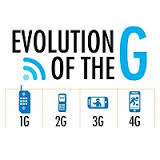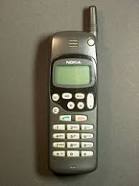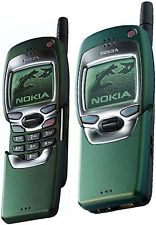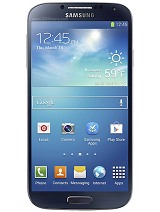
Generations of the Mobile Phone.
© copyright phonearena.com
0G Phones The basis of modern mobile phones is the celular concept. Prior to this there were many radio telephones using the PTT (Push To Talk technology). This used the whole of the available spectrum to connect one phone so the technology is unable to scale to the level needed for the modern mobile phone user. Hence a different model for mobile phone networks was needed.
 1G Phones The first mobile phones were based on
analogue technology. These phones were based on circuit switching, so still
used a dedicated frequency, thus still a capacity issue. The cellular concept
allowed for many cells sharing the same frequencies, and as these cells are
small, a larger overall phone capacity is possible. The only function of these
phones was to make phone calls; the ability to move around when speaking was
novel. Phones of this generation were large and heavy, mainly caused by the battery
size.
1G Phones The first mobile phones were based on
analogue technology. These phones were based on circuit switching, so still
used a dedicated frequency, thus still a capacity issue. The cellular concept
allowed for many cells sharing the same frequencies, and as these cells are
small, a larger overall phone capacity is possible. The only function of these
phones was to make phone calls; the ability to move around when speaking was
novel. Phones of this generation were large and heavy, mainly caused by the battery
size.
 2G Phones A switch to digital technology allowed
for digital communications with more sharing of the frequency and greater
capacity. These phones also provided SMS messages and a (slow) access to the
Internet. Typical phones of this era are the Nokia 7110 which was the first
to provide Internet access. Initial Internet access was by way of dial-up
connection but later with GPRS always-on technology the modern way to
access the Internet was available. Later EDGE technology speeded up the
network connections.
2G Phones A switch to digital technology allowed
for digital communications with more sharing of the frequency and greater
capacity. These phones also provided SMS messages and a (slow) access to the
Internet. Typical phones of this era are the Nokia 7110 which was the first
to provide Internet access. Initial Internet access was by way of dial-up
connection but later with GPRS always-on technology the modern way to
access the Internet was available. Later EDGE technology speeded up the
network connections.
 3G Phones The search for speed began with 3G
mobile phone technology. The demand for services based on the Internet led
to a demand for capacity and speed on the network. The basic 3G networks were
based on UTMS technology operating at 800MHz and 2.1GHz. This added capacity
allowed for video and even 3GTV experiments. Typical phones of this era was the
Nokia N95. Later developments for the 3G network was the speed up provided
by HSPA software upgrade.
3G Phones The search for speed began with 3G
mobile phone technology. The demand for services based on the Internet led
to a demand for capacity and speed on the network. The basic 3G networks were
based on UTMS technology operating at 800MHz and 2.1GHz. This added capacity
allowed for video and even 3GTV experiments. Typical phones of this era was the
Nokia N95. Later developments for the 3G network was the speed up provided
by HSPA software upgrade.
 4G Phones Again a new network with the drive
for speed and capacity. A fully data-based model showing the focus on data on
the Internet. The technology used is LTE, Long Term Evolution, providing for
incremental development. The proposed implementation for SMS and Phone calls
is via data-driven apps; Internet messaging and VOIP phone calls.
Currently these services can be swapped to the GSM network. Recent development
of 4G is towards LTE Advance labelled as 4G+.
4G Phones Again a new network with the drive
for speed and capacity. A fully data-based model showing the focus on data on
the Internet. The technology used is LTE, Long Term Evolution, providing for
incremental development. The proposed implementation for SMS and Phone calls
is via data-driven apps; Internet messaging and VOIP phone calls.
Currently these services can be swapped to the GSM network. Recent development
of 4G is towards LTE Advance labelled as 4G+.
 5G PhonesThe initial implementations of the 5G network
are a further evolution from 4G, more speed and capacity provided by various
technical enhancements. Later implementation of mmWave 5G will be a significant
change. The evolution simplifies the core network bringing much to the
periphery and within the cloud. Massive MIMO provides the extra speed. Currently
(July 2019) there is controversy in the use of Huawei and other Chinese
equipment in the 5G networks in the UK. The only non-Chinese 5G phone available
now is the Samsung Galaxy S10 5G.
5G PhonesThe initial implementations of the 5G network
are a further evolution from 4G, more speed and capacity provided by various
technical enhancements. Later implementation of mmWave 5G will be a significant
change. The evolution simplifies the core network bringing much to the
periphery and within the cloud. Massive MIMO provides the extra speed. Currently
(July 2019) there is controversy in the use of Huawei and other Chinese
equipment in the 5G networks in the UK. The only non-Chinese 5G phone available
now is the Samsung Galaxy S10 5G.
*u* ©mobilephonetechnology.co.uk all rights reserved 2017- 2025



